Introduction
Introduced earlier this year, the Nikon D7100 has a 24Mpix APS-C format CMOS sensor in line with both the new D5200 and entry-level D3200 models but what makes this particular model stand out is the fact this is the first stock DSLR from the firm to omit an optical low-pass filter (OLPF).As we’ve previously disclosed in part I, this configuration is capable of revealing extraordinarily high levels of fine detail at low ISOs. In fact, with certain lenses we revealed the new camera is capable of achieving an increase of up to 50% percent in sharpness over the firm’s previous 16-Mpix D7000 model.
As a 24Mpix APS-C format camera, the D7100 has an equivalent pixel density to that of a 56-Mpix full-frame 35mm camera without a blur filter (OLPF) in place and is therefore particularly demanding on the quality of the lens mounted. However, while certain models may well be able to out-resolve the sensor and offer significant benefits in detail rendition and sharpness other, lesser quality lenses may also benefit, just not so much.
The labs have analyzed the optical performance of nearly 60 standard and portrait prime and zoom models made by Nikon and third-party makers, including 15 primes between 40-60mm in focal length, a further 20 primes between 70 and 135mm and 23 zooms from the earlier 17-35mm to the newer 24-85mm. As we mentioned in part I, Sigma has yet to ship the high-speed 18-35mm f/1.8 DC HSM A in Nikon mount, and we’re still waiting to analyze the Nikon AF-S DX Nikkor 18-140mm f/3.5-5.6G ED VR, but they should arrive soon and both will be analyzed and added to the database.
It comes as little surprise to see modern lens designs occupying the top slots in this group of focal lengths.
If autofocus and image quality are paramount the choice is a costly one; $2199 will secure you the Nikon AF-S Nikkor 85mm f/1.4G, which also achieves the highest overall sharpness score of 16P-Mpix. If you’re looking for a bargain, the new f/1.8G version is promising.
Although it has a slower maximum aperture, obviously, it’s more compact, significantly cheaper and nearly as sharp. There are still some savings to be when compared to the modestly priced f/1.4 Sigma, and it’s sharper, and has less troublesome chromatic aberration.
 |
 |
 |
 |
| Nikon AF-S Nikkor 85mm f/1.4G | 2199 | 30 | 16 |
| Nikon AF-S NIKKOR 85mm f/1.8G | 690 | 30 | 15 |
| Sigma 85mm F1.4 EX DG HSM Nikon | 969 | 27 | 12 |
| Samyang 85mm f/1.4 Aspherique IF Nikon | 328 | 26 | 14 |
| Nikon AF Nikkor 85mm f/1.4D IF | 1230 | 25 | 14 |
| Carl Zeiss Planar T 85mm f/1.4 ZF2 Nikon | 1280 | 25 | 14 |
| Nikon AF Nikkor 50mm f/1.4D | 329 | 24 | 14 |
| Sigma 50mm F1.4 EX DG HSM Nikon | 499 | 24 | 13 |
| Nikon AF Nikkor 85mm f/1.8D | 460 | 24 | 14 |
| Tamron SP 90mm F/2.8 Di MACRO 1:1 VC USD Nikon | 749 | 24 | 13 |
| Nikon AF-S Nikkor 50mm f/1.4G | 448 | 23 | 13 |
| Sigma 70mm F2.8 EX DG Macro Nikon | 499 | 23 | 11 |
| Carl Zeiss Makro-Planar T 50mm f/2 ZF2 Nikon | 1280 | 22 | 14 |
| Tamron SP AF 90mm F/2.8 Di MACRO Nikon | 460 | 22 | 11 |
| Nikon AF-S NIKKOR 50mm f/1.8G | 219 | 22 | 14 |
| Tamron SP AF 60mm F/2 Di II LD [IF] MACRO Nikon | 499 | 21 | 14 |
| Nikon AF Micro-Nikkor 60mm f/2.8D | 460 | 21 | 13 |
| Nikon AF Nikkor 50mm f/1.8D | 134 | 20 | 13 |
| Carl Zeiss Planar T 50mm f/1.4 ZF2 Nikon | 725 | 20 | 12 |
| Nikon AF-S DX Micro NIKKOR 85mm f/3.5G ED VR | 500 | 17 | 10 |
The Samyang must also be worth considering. It’s not an AF model but it’s solidly made, has a bright f/1.4 maximum aperture and costs just $328. With that specification it would make a good choice for outdoor portraits and, as a manual focus lens, it will likely appeal to budding movie-makers as well.
Bear in mind on the D7100, 85mm lenses have a similar field of view to a 130mm focal length on a 35mm full-frame body, and are typically more suited to outdoor portraits than in a small studio. It’s one of the reasons why the shorter 50mm lenses (which approximate the field of view of an 80mm) are enjoying a renaissance.
At $329 the older AF Nikkor 50mm f/1.4D, if it can be found, is a (very) slightly better performer optically overall and marginally better at full aperture than the newer, more expensive SWM (ultrasonic motor) equipped AF-S Nikkor version. The Sigma 50mm f/1.4 EX DG HSM is another fine performer though, somewhat surprisingly; at $499 it’s the dearest of the three.
If the range of models offered wasn’t complicated enough, Nikon also offers a modestly priced ($229), lightweight AF-S 50mm f/1.8G model as well as an older film-era AF-D type at just $134. There are also some attractive macro lenses, which, if you don’t need the faster maximum aperture, can be a better all-round choice for their consistently high image quality. Of those, the Sigma 70mm is the best performer overall but the Tamron 60mm and the Nikon equivalent are both technically sharper.
As for the best performing standard prime lenses on the APS-C format Nikon D7100, the full-frame Sigma 35mm f/1.4 DG HSM A continues to lead the way with it achieving the best overall image quality score of those tested, followed by the modestly priced AF-S DX Nikkor 35mm f/1.8 G (and best value of the group).
 |
 |
 |
 |
| Sigma 35mm F1.4 DG HSM A Nikon | 899 | 32 | 16 |
| Nikon AF-S DX Nikkor 35mm f/1.8G | 195 | 26 | 12 |
| Samyang 35mm F1.4 AS UMC Nikon | 599 | 26 | 11 |
| Sigma 30mm F1.4 DC HSM A Nikon | 499 | 26 | 15 |
| Carl Zeiss Distagon T 35mm f/2 ZF2 Nikon | 1005 | 25 | 13 |
| Carl Zeiss Distagon T 35mm f/1.4 ZF2 Nikon | 1843 | 25 | 13 |
| Nikon AF-S NIKKOR 35mm f/1.4G | 1797 | 25 | 14 |
| Carl Zeiss Distagon T 28mm f/2 ZF2 Nikon | 1283 | 24 | 14 |
| Sigma 30mm F1.4 EX DC HSM Nikon | 440 | 22 | 10 |
| Sigma 28mm F1.8 EX DG ASP Macro Nikon | 449 | 22 | 14 |
| Nikon AF-S DX Micro NIKKOR 40mm f/2.8G | 280 | 21 | 15 |
| Nikon AF Nikkor 35mm f/2D | 365 | 21 | 13 |
| Nikon AF-S NIKKOR 28mm f/1.8G | 699 | 21 | 13 |
| Tokina AT-X M35 PRO DX AF 35mm f/2.8 Macro Nikon | 599 | 20 | 13 |
| Nikon AF Nikkor 28mm f/2.8D | 280 | 19 | 11 |
In third place is another full-frame f/1.4 lens, though like other models from the South Korea based firm it lacks autofocus. At $599, it’s a $1200 cheaper than the equivalent full-frame autofocus f/1.4 model from Nikon. That said, while the high-end Nikkor lens achieves a lower DxOMark score of 25 points overall, it has higher levels of sharpness at wider apertures.
If choosing a slightly faster f/1.4 model based on price, the new upgraded APS-C format Sigma 30mm f/1.4 DC HSM A at $499 is very close in sharpness to its bigger, pricier full-frame sibling.Although it sits in fourth place in our rankings, it’s one of the sharpest models in this range of focal lengths.
Macro lenses are attractive for their versatility and there are nearly always very high performers optically. Nikon offers a wide range of models for both FX and DX format cameras. As the joint second sharpest lens in the group (scoring 15P-Mpix), the AF-S DX Micro Nikkor 40mm f/2.8G is both small and light in weight and it‘s accessibly priced at $280.
As we’ve seen in our previous reviews the new full-frame Tamron SP 24-70mm f/2.8 Di VC USD has very high image quality, and on the D7100 it holds the highest DxOMark lens score for a standard zoom at 21 points. The DxOMark lens score is an overall mark, however, and sharpness is just one of the criteria that contributes to the ranking.
Mounted on the D7100 both the full-frame $1,800 Nikon AF-S Nikkor 24-70mm f/2.8G ED and the dedicated APS-C format Sigma 17-50mm f/2.8 EX DC OS HSM lens are sharper, mostly at the longer focal lengths. In fact, the Tamron doesn’t perform that well at 70mm until stopped down to f/8.
Of the top three, the Sigma is the more consistent performer over the range of focal lengths on the Nikon D7100. At just $669, and with an arguably more useful range, equivalent to a 26-77mm on a 35mm camera, the Sigma stands out as being exceptional value for money.
Although lacking the constant, fast f/2.8 maximum aperture of the top three models, the new Nikon AF-S 18-35mm f/3.5-4.5G ED also achieves a DxOMark score of 20 points for image quality (in effect making it joint second), albeit with a lower average sharpness score of 11P-Mpix. The slower variable aperture makes for a much smaller and lighter weight lens, and offers a good balance between image quality and portability.
At $750, it’s slightly more expensive than the Sigma but it is a full-frame lens and could be a very worthwhile addition if you use both DX and FX bodies regularly.
Also worth looking at are the modestly priced Sigma 18-50mm f/2.8 EX DC Macro HSM and 17-70mm f/2.8-4 DC MACRO OS HSM C models.
Both those offer similar overall image quality to the professional grade AF-S DX Nikkor 17-55mm f/2.8G IF-ED (although not the same durable build). All three achieve a DxOMark lens score of 19 points and are tied in third place, but the Sigma models outperform the Nikon in our Sharpness (P-Mpix) scores.
This is mostly all due to the lack-lustre performance of the Nikon at the 55mm focal length. That’s not just the performance at full aperture, even stopped down the Nikon has low levels of sharpness at the longer end of the zoom range. At all other focal lengths, the Nikon performs well in comparison, at least in the centre of the image field.
In part III of this guide, we’ll be looking at the best performing primes and zooms covering wide-angle and telephoto focal lengths.
If you have a Nikon D7100 and a favorite lens, we would very much like to hear from you. Please leave a comment below, stating what lens it is and why you like it.


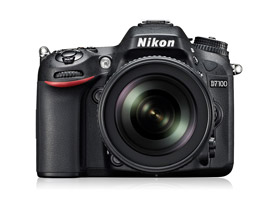
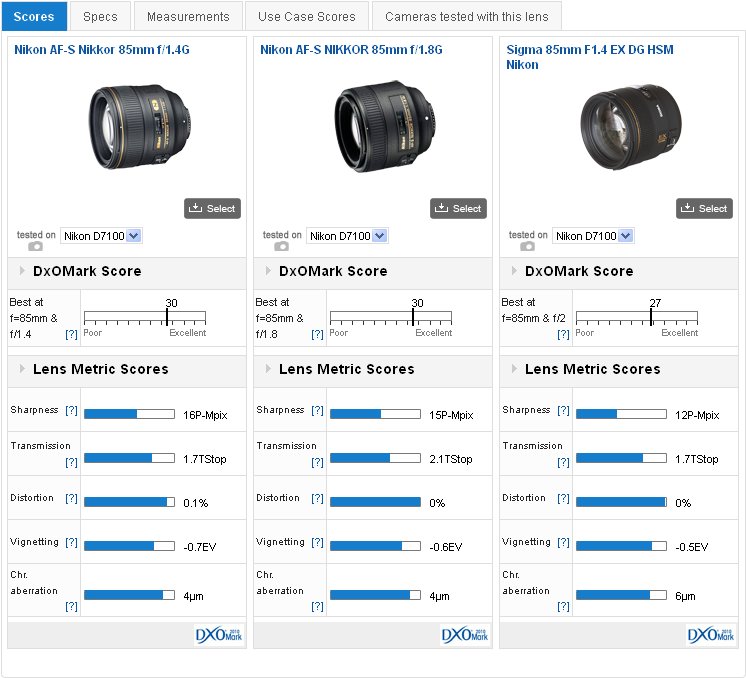

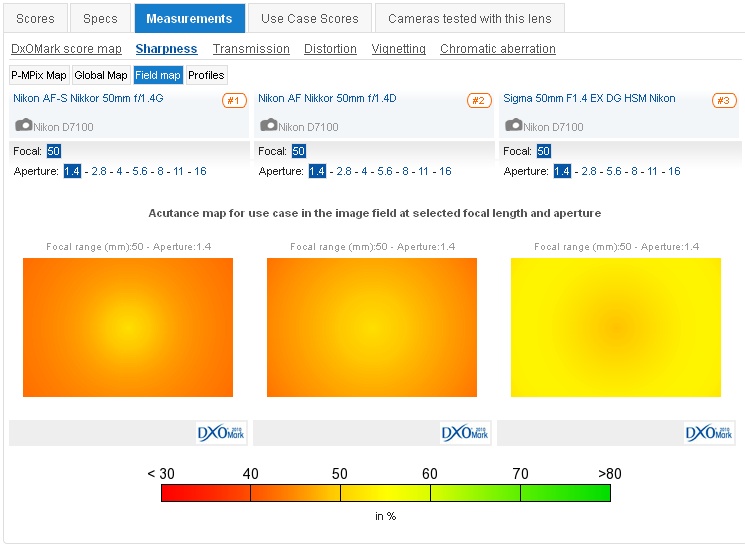

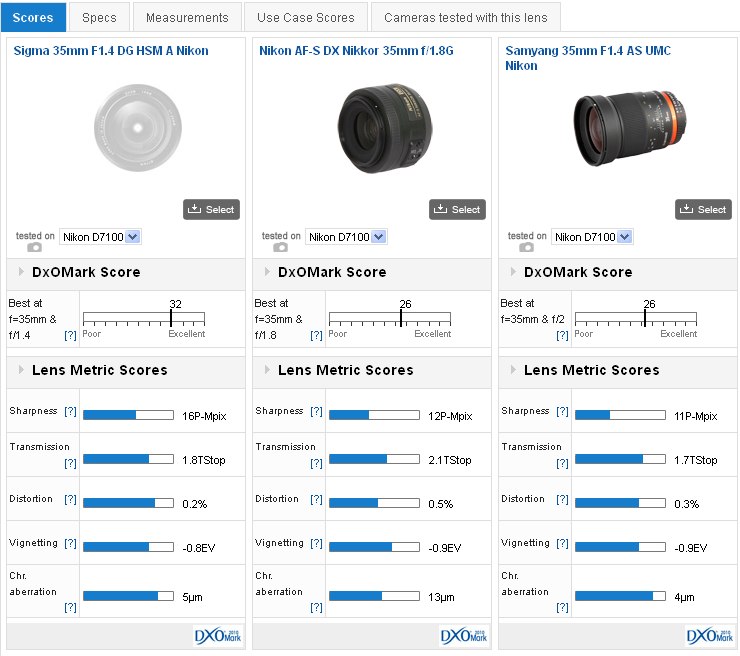
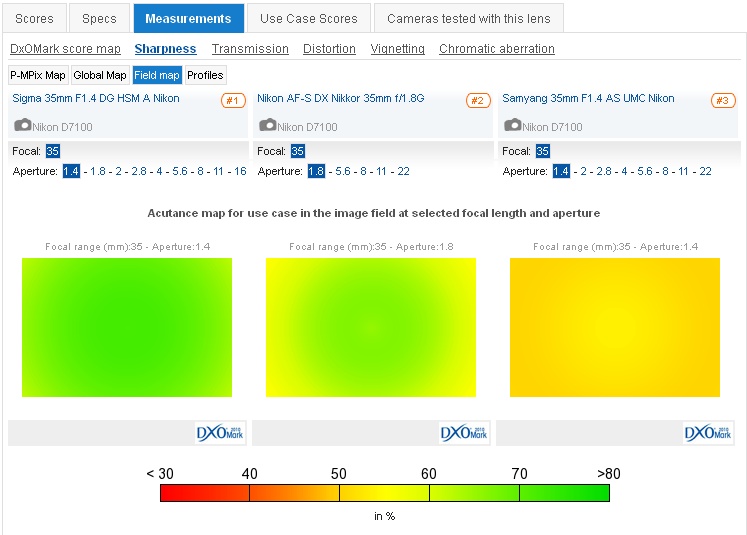
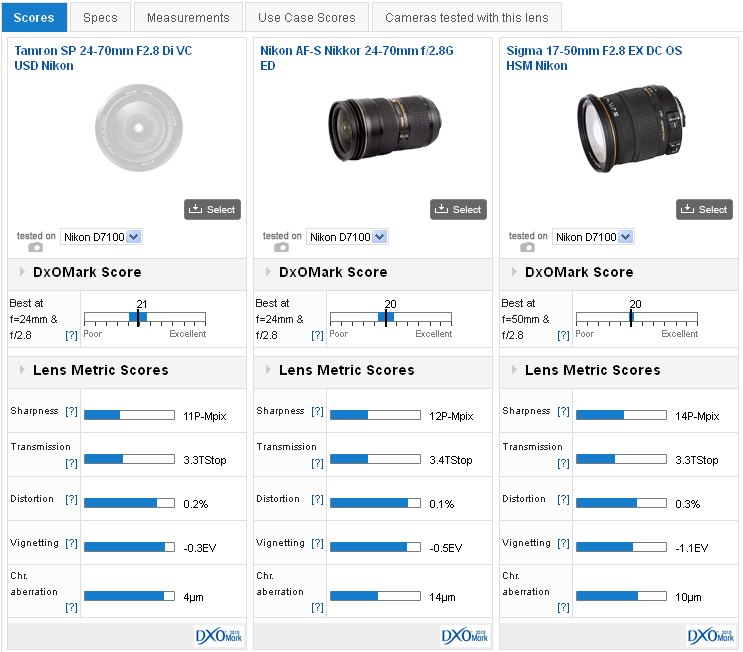
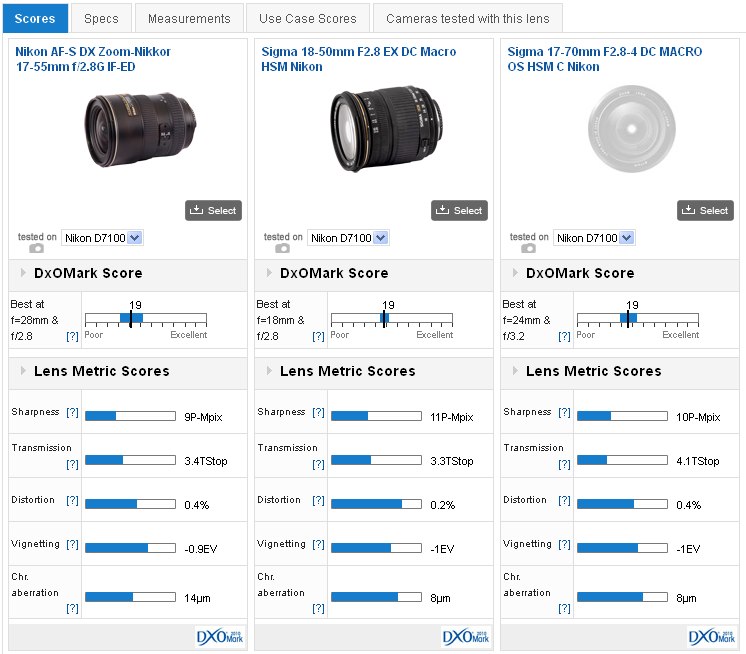
DXOMARK encourages its readers to share comments on the articles. To read or post comments, Disqus cookies are required. Change your Cookies Preferences and read more about our Comment Policy.